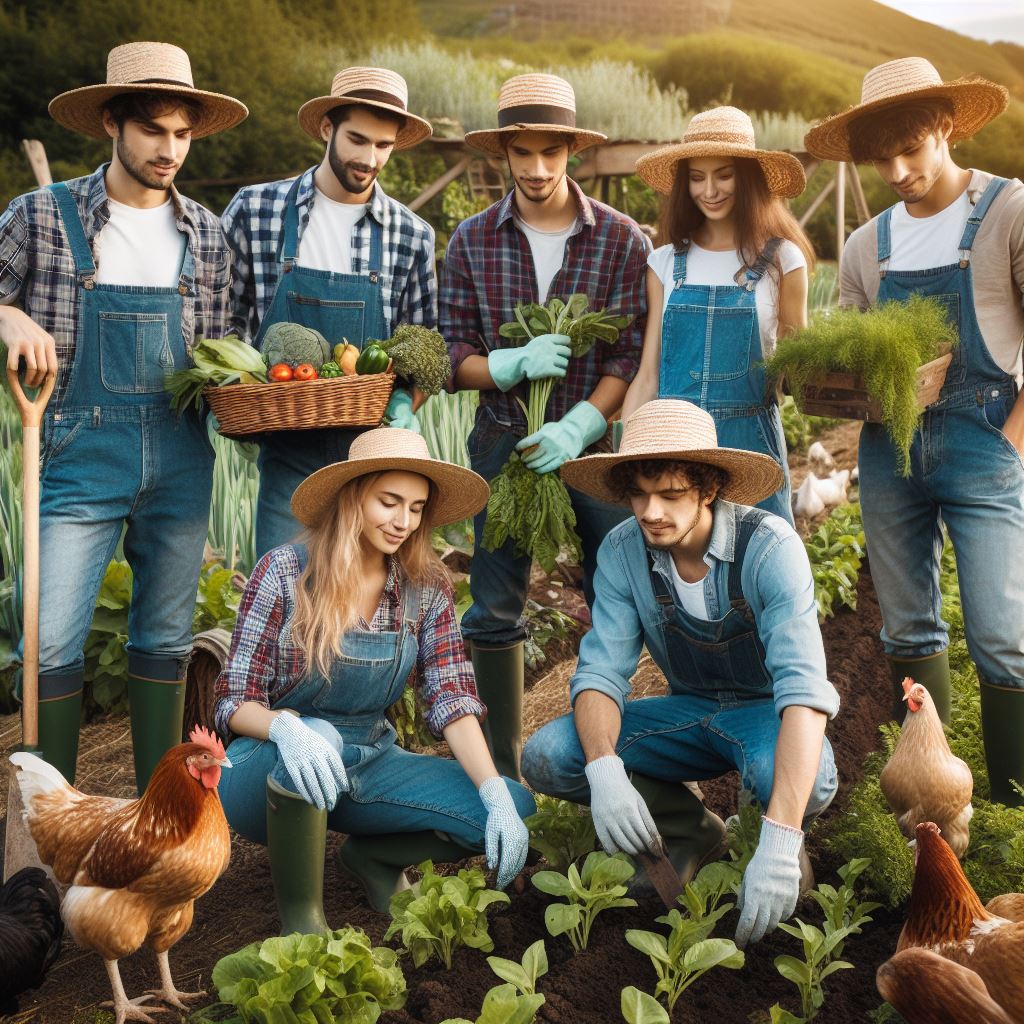Introduction
Raising livestock in limited spaces presents a unique set of challenges that require innovative solutions and careful management practices.
Whether you’re a backyard hobbyist or a small-scale farmer, making the most of limited space is essential for the well-being of both your animals and your operation’s success.
One of the primary challenges faced in such environments is the scarcity of space.
Limited acreage means that every square foot counts, making efficient space utilization critical.
Additionally, with urbanization encroaching on traditional agricultural lands, small-scale livestock farmers often find themselves adapting to smaller plots or even utilizing non-traditional spaces like rooftops or urban lots.
Efficient livestock management in these environments is not just about maximizing productivity; it’s also about ensuring the health and welfare of the animals.
Overcrowding can lead to stress, disease, and reduced productivity.
Therefore, finding the right balance between stocking density and animal comfort is paramount.
Furthermore, limited space often necessitates creative solutions for housing, feeding, and waste management.
Compact housing designs, vertical integration, and automated feeding systems can help optimize space usage and streamline daily operations.
Moreover, in urban or suburban settings, odor and waste management become significant concerns.
Implementing odor control measures and efficient waste management systems is essential not only for compliance with local regulations but also for maintaining good relationships with neighbors and the surrounding community.
In summary, while raising livestock in limited spaces presents its own set of challenges, it also offers opportunities for innovation and creativity.
By adopting efficient management practices, prioritizing animal welfare, and embracing creative solutions, small-scale livestock farmers can thrive in even the most confined environments.
Selecting the Appropriate Livestock
Importance of Choosing Livestock Species Suitable for Limited Spaces
- When raising livestock in limited spaces, it is crucial to select species that can adapt well.
- Choosing the right livestock ensures their well-being and maximizes the use of available resources.
- Livestock that are suitable for confined areas require less space, making management easier.
- They also tend to produce less waste, reducing the need for extensive waste management systems.
- By selecting appropriate livestock, you can optimize productivity and ensure a sustainable operation.
Examples of Livestock Commonly Raised in Confined Areas
- Rabbits: Rabbits are an excellent choice for limited spaces due to their small size and low space requirements.
- Chickens: Chickens are widely raised in confined areas, such as backyard coops, and provide a source of both meat and eggs.
- Quail: Quail are small-sized birds that can be raised in small enclosures and are valued for their eggs and meat.
- Guinea Pigs: Guinea pigs are docile animals that can be comfortably raised indoors and are popular as pets and food source.
- Micro-livestock: Animals like insects, snails, and small fish can also be considered for livestock production in limited spaces.
Characteristics and Benefits of Each Selected Livestock Species
- Rabbits: Rabbits are known for their high reproduction rate, quick growth, and efficient feed conversion. They require minimal space, multiply rapidly, and can provide a sustainable source of meat and fur.
- Chickens: Chickens are easy to handle and provide a constant supply of eggs and meat in a confined space. They efficiently convert kitchen scraps into nutrition-rich eggs and can also control pests in the surrounding area.
- Quail: Quail require little space and have a short maturity period, allowing for quick and regular harvest. Their small size makes them suitable for urban environments, and their eggs are highly valued for their rich flavor.
- Guinea Pigs: Guinea pigs are gentle and require minimal space, making them suitable for indoor raising. They have a high feed conversion rate and their meat is low in cholesterol, providing a healthy alternative.
- Micro-livestock: Insects, such as mealworms or crickets, require very little space and have high protein content. Including them in livestock production can increase the availability of protein-rich food with low environmental impact.
In fact, selecting the appropriate livestock species is vital when raising livestock in limited spaces.
Choosing livestock that are well-suited for confined areas ensures their welfare, maximizes productivity, and optimizes resource use.
Rabbits, chickens, quail, guinea pigs, and micro-livestock are examples of species commonly raised in limited spaces.
Each has unique characteristics and benefits, such as efficient feed conversion, high reproduction rates, and adaptability to confined environments.
By considering these factors, individuals can successfully raise livestock in limited spaces, promoting self-sufficiency and sustainable practices.
Designing a Suitable Livestock Housing
Importance of Designing an Appropriate Housing System for Efficient Space Utilization
Raising livestock in limited spaces requires careful planning and designing of suitable housing systems.
Efficient space utilization is crucial to maximize productivity and ensure the well-being of the animals.
Proper housing design enables the livestock to thrive in limited spaces, providing a comfortable and healthy environment.
Tips and Considerations for Constructing Livestock Housing in Limited Spaces
- Maximizing vertical space: In a limited area, utilizing the vertical space is essential.
Construct multi-level enclosures or use racks and shelves for stacking animal crates.
This strategy allows for a larger number of animals without overcrowding the floor space. - Using movable or modular structures: Opt for housing that can be easily reconfigured or moved.
Modular structures such as prefabricated sheds or portable containers offer flexibility in adjusting the layout.
This flexibility aids in adapting to changes in herd size or utilizing different areas for various purposes.
Importance of Proper Ventilation, Lighting, and Insulation in the Housing
Proper ventilation plays a crucial role in maintaining good air quality inside the livestock housing.
Adequate airflow prevents the accumulation of harmful gases, reduces moisture levels, and prevents heat stress.
Natural ventilation systems, such as ridge vents or exhaust fans, aid in maintaining optimal air circulation.
Sufficient lighting is vital for livestock’s health and productivity.
Natural lighting is ideal, providing a more natural environment and reducing energy costs.
Windows or transparent roof panels can be incorporated into the housing design to allow natural light.
Insulation is necessary to regulate temperature extremes and provide thermal comfort.
Well-insulated walls, roofs, and floors help to maintain suitable temperature conditions during hot or cold seasons.
This not only protects the animals from weather-related stress but also contributes to energy efficiency.
Transform Your Agribusiness
Unlock your farm's potential with expert advice tailored to your needs. Get actionable steps that drive real results.
Get StartedIn short, designing a suitable housing system for raising livestock in limited spaces is of utmost importance.
Efficient space utilization, maximizing vertical space, and using movable or modular structures are key considerations.
Proper ventilation, lighting, and insulation contribute to the well-being and productivity of the animals.
By incorporating these tips and considerations, farmers can successfully raise livestock in limited spaces while ensuring their welfare.
Read: Innovative Farming: The Youth’s Approach
Nutritional Management
Significance of Providing Balanced Nutrition
- Providing balanced nutrition is crucial in ensuring the overall health and well-being of livestock.
- It promotes proper growth, development, and reproduction, leading to optimal productivity.
- Imbalanced nutrition can result in stunted growth, reduced milk or egg production, and higher susceptibility to diseases.
- In limited spaces, where livestock may have restricted access to grazing or natural forage, providing a well-balanced diet is even more critical.
Importance of Creating a Feeding Plan and Schedule
- A feeding plan should be tailored to the specific needs of each livestock species to ensure their nutritional requirements are met.
- Factors such as age, breed, size, and purpose (meat production, milk production, or breeding) must be considered.
- A well-designed feeding plan optimizes livestock performance and minimizes the risk of nutrient deficiencies or excesses.
- Feeding schedules ensure regular feed availability, preventing hunger and reducing aggressive behavior due to competition for food.
Methods for Optimizing Feed Usage and Reducing Wastage
- Using appropriate feeders can help minimize feed wastage by preventing spillage and spoilage.
- Feeders designed for specific livestock species ensure efficient consumption and reduce the risk of selective feeding.
- Implementing restricted access to feeding areas can prevent overconsumption and enhance feed utilization.
- For example, using feeders with limited openings allows only one animal at a time to feed, ensuring fair access to feed.
- Regular monitoring of feed intake and body condition enables adjustments in feed quantity or composition to meet changing needs.
- Implementing feeding strategies such as total mixed ration (TMR) or partial mixed ration (PMR) can optimize feed utilization.
- TMR involves blending all required nutrients into a single feed, while PMR combines a partial mix with a forage component.
- These methods ensure animals consume a balanced diet with all necessary nutrients in every bite.
Read: From Conventional to Organic: A Farmer’s Path

Waste Management
Challenges of Waste Management in Limited Spaces
Raising livestock in limited spaces presents challenges in managing waste due to potential odor and health issues.
Tips for Effective Waste Management
To ensure effective waste management in limited spaces, proper manure storage and disposal techniques should be followed.
- Designate a specific area for manure storage: Create a designated space for storing manure, preferably away from living areas and water sources.
- Use appropriate storage containers: Choose containers that are easy to clean and maintain to prevent the accumulation of bacteria and pests.
- Regularly clean and empty containers: Clean and empty manure storage containers regularly to prevent odor build-up and improve air quality.
- Proper manure disposal: Dispose of manure in a responsible manner, following local regulations and guidelines.
- Consider alternative disposal methods: Explore options such as composting, recycling, or utilizing manure for energy production.
The Benefits of Composting and Recycling Waste
Composting and recycling waste can have several benefits, including the production of natural fertilizers.
- Composting: Composting is the process of decomposing organic waste and turning it into nutrient-rich compost.
- Reduces waste: Composting reduces the volume of waste generated on the farm, minimizing the need for external waste disposal methods.
- Improves soil quality: Compost adds nutrients and improves soil structure, enhancing the growth of plants and crops.
- Enhances water retention: Compost helps soil retain water, reducing the need for irrigation and improving drought resistance.
Recycling waste for use as fertilizers
Livestock waste can be recycled as organic fertilizer, providing essential nutrients for plants.
- Natural fertilizer: Livestock manure contains valuable nutrients like nitrogen, phosphorus, and potassium that plants need for healthy growth.
- Cost-effective solution: Utilizing livestock waste as fertilizer minimizes the need for expensive chemical fertilizers.
- Environmental sustainability: Recycling waste reduces the reliance on synthetic fertilizers, which can harm the environment and water sources.
In general, managing waste in limited spaces can be challenging, but with proper techniques like designated storage areas, regular cleaning, and responsible disposal, it can be effectively controlled.
Additionally, composting and recycling waste offer numerous benefits, both for waste reduction and for producing natural fertilizers.
By implementing these tips and practices, livestock owners can ensure a healthier and more environmentally friendly waste management system.
Read: Vineyard Dreams: Sustainable Wine Making
Health and Disease Prevention
Increased Risk of diseases in confined spaces and the importance of preventative measures
Raising livestock in limited spaces presents certain challenges, especially when it comes to their health and disease prevention.
Confining animals in close quarters can increase the risk of diseases spreading rapidly among them.
Therefore, it is crucial to implement preventative measures to minimize this risk.
1. Quarantine:
- Isolate newly introduced livestock for a certain period to prevent the spread of potential diseases.
- Observe animals for any signs of illness during the quarantine period.
- Seek veterinary advice if any abnormalities are detected.
2. Proper Ventilation
- Ensure adequate ventilation in livestock housing to minimize the buildup of harmful pathogens.
- Poor air circulation can lead to respiratory issues and increase the spread of diseases.
- Install fans or ventilation systems to maintain a healthy environment for the animals.
3. Sanitation and Cleanliness
- Regularly clean and disinfect livestock housing areas to eliminate pathogens.
- Remove manure, bedding, and any other organic waste to prevent the buildup of harmful bacteria.
- Use appropriate cleaning agents and follow proper sanitization protocols recommended by experts.
Maintaining good hygiene and cleanliness within livestock housing
1. Separate Feeding and Sleeping Areas
- Designate separate areas for feeding and sleeping to reduce contamination and disease transmission.
- This practice prevents the animals from eating in areas contaminated by feces or urine.
2. Proper Waste Disposal
- Implement an efficient waste management system to ensure cleanliness.
- Dispose of waste in a designated area, away from livestock housing, to prevent disease transmission.
- Consider composting methods for manure management, which can have additional benefits for the environment.
3. Adequate Bedding
- Provide clean and dry bedding for livestock to minimize the risk of infections.
- Change bedding regularly to maintain cleanliness and prevent the buildup of harmful bacteria.
- Consider using materials such as straw or wood shavings that provide comfort and absorb moisture effectively.
Significance of regular health check-ups and vaccination protocols
Regular health check-ups and vaccination protocols are crucial to ensuring the well-being of livestock in limited spaces.
1. Veterinary Check-ups
- Schedule regular check-ups with a veterinarian to monitor the overall health of the animals.
- Promptly address any health concerns or disease symptoms identified during check-ups.
- Regular visits help to identify potential health issues early, allowing for timely intervention.
2. Vaccination Programs
- Consult with a veterinarian to develop a customized vaccination program for your livestock.
- Vaccinations help prevent the spread of infectious diseases and improve overall herd immunity.
- Stay updated on new vaccinations or booster shots recommended by experts to ensure maximum protection.
It is essential to prioritize the health and well-being of livestock in limited spaces.
By implementing preventative measures, maintaining proper hygiene, and following regular health check-ups and vaccination protocols, the risk of diseases can be significantly reduced.
Remember, healthy animals lead to a thriving livestock operation.
Read: Next-Gen Farmers: Shaping Agriculture’s Future
Maximizing Outdoor Space
Access to outdoor areas has a positive impact, if available, for raising livestock in limited spaces.
- Outdoor access allows livestock to experience fresh air, sunshine, and natural grazing opportunities.
- Animals raised outdoors tend to be healthier, more active, and have a better overall well-being.
- Natural foraging on grass and plants can improve their diet and digestion.
- Exposure to sunlight helps animals to synthesize vitamin D, which is essential for their health.
- Access to outdoor areas reduces stress and behavioral issues, resulting in calmer and happier animals.
Setting up secure and suitable outdoor spaces is crucial for livestock to roam, graze, or exercise in limited areas.
- Assess the available space and identify the most suitable areas for outdoor access.
- Use sturdy fencing to create boundaries and prevent livestock from wandering off or predators from entering.
- Ensure fences are high enough to discourage jumping and strong enough to withstand the pressure from large animals.
- Regularly inspect fences for any damages or weaknesses and repair them promptly.
- Provide shelter within the outdoor space to protect animals from adverse weather conditions.
- Install watering troughs or access to a nearby water source to ensure livestock stay hydrated.
- Rotate grazing areas if possible, allowing the land to recover and ensuring a fresh food supply for the animals.
- Implement a suitable grazing management plan to prevent overgrazing and maintain the health of the vegetation.
- Consider using movable electric fencing systems to create temporary grazing areas or divide larger spaces.
By implementing these tips and utilizing available outdoor space efficiently, you can provide a better environment for your livestock.
Conclusion
Managing livestock in limited spaces necessitates a strategic approach and meticulous planning to ensure both the animals’ well-being and the farm’s success.
Careful planning is essential to optimize the use of available space while maintaining a healthy and comfortable environment for the livestock.
This involves considerations such as designing efficient housing structures, implementing proper ventilation systems, and managing waste effectively to prevent overcrowding and minimize stress on the animals.
Efficient management practices are vital for maintaining the health and productivity of the livestock.
This includes regular health monitoring, providing a balanced diet tailored to the animals’ needs, and implementing preventive measures to mitigate the risk of diseases.
Additionally, proper record-keeping and scheduling of tasks ensure smooth operations and prompt interventions when necessary.




